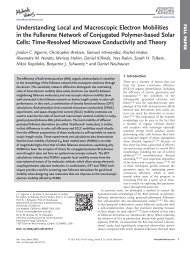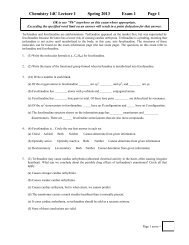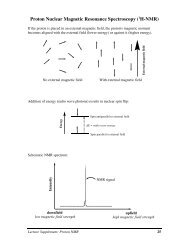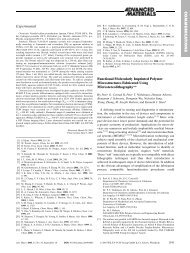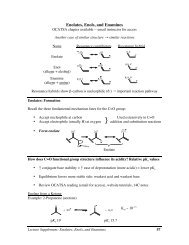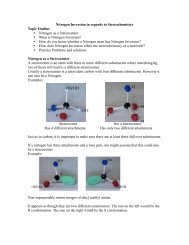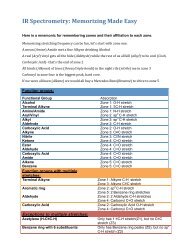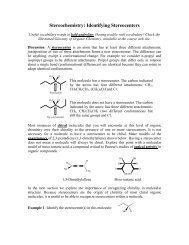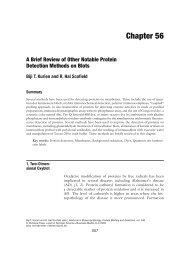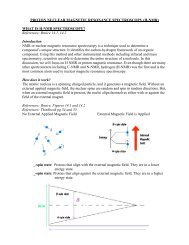Nucleotides and Nucleic Acids
Nucleotides and Nucleic Acids
Nucleotides and Nucleic Acids
You also want an ePaper? Increase the reach of your titles
YUMPU automatically turns print PDFs into web optimized ePapers that Google loves.
<strong>Nucleotides</strong> <strong>and</strong> <strong>Nucleic</strong> <strong>Acids</strong><br />
Brief History… 1<br />
1869 - Miescher – Isolated nuclein from soiled b<strong>and</strong>ages<br />
1902 - Garrod – Studied rare genetic disorder: Alkaptonuria; concluded that specific<br />
gene is associated with absence of a specific enzyme.<br />
1903 - Sutton – Chromosome structure<br />
1913 - Morgan – Gene mapping<br />
1926 - Sumner – Purified Urease; identified enzyme to be proteins<br />
1928 - Griffith – Transforming Principle – a chemical transferred from dead bacteria to<br />
living cells caused genetically converted strains (“transformation”)<br />
1944 - Avery, McCarty, <strong>and</strong> Macleod – Identified Griffith’s “transformation principle”<br />
as DNA<br />
1947 - Chargaff – Base pairing<br />
1950’s - Franklin – X-ray of DNA<br />
1953 - Watson <strong>and</strong> Crick – DNA double helix<br />
Three components make up a nucleotide:<br />
1. Heterocyclic base – either a pyrimidine or a purine<br />
- Heterocyclic – “molecule with at least one ring containing an atom other than carbon” 2<br />
• Pyrimidine – aromatic organic compound with 2 nitrogens at C1 & C3 of a sixmembered<br />
ring.<br />
1 http://kirkpatrick.troyhigh.com/page2.html<br />
2 Hardinger. Chem14C Thinkbook. p. 101.
o Pyrimidines in DNA & RNA:<br />
• Purine – aromatic organic compound that consists of a pyrimidine ring <strong>and</strong> an<br />
imadazole ring (C3H4N2).<br />
o Purines in DNA & RNA:<br />
o Other common purines:<br />
Caffeine Theobromine (found in chocolate)<br />
- Properties of pyrimidines & purines<br />
- Pyrimidine conformations are planar; purines are somewhat puckered<br />
- Plain pyrimidines <strong>and</strong> purines have low solubility (not many polar bonds)
- Cytosine, Thymine, Uracil, Guanine, <strong>and</strong> Adenine are more soluble<br />
because they have many polar groups that are available for hydrogen<br />
bonding.<br />
- Because they are aromatic, pyrimidines <strong>and</strong> purines can all absorb UV light.<br />
- DNA & RNA concentration in a sample can be found by measuring UV<br />
absorbance 3 .<br />
2. Carbohydrate – The carbohydrate component consists of a sugar, which is usually a<br />
pentose. Each nucleic acid has a different carbohydrate.<br />
Note: Superscript prime is used to number the carbons when a heterocyclic base is<br />
attached to the carbohydrate (i.e. 1’, 2’ instead of 1, 2).<br />
3. Phosphoric acid – forms phosphodiester bonds between nucleotides<br />
Nucleosides<br />
- formed by covalently joining the sugar to a<br />
heterocyclic base (bond formed is called a<br />
glycosidic bond.)<br />
Phosphoric acid<br />
Helpful mnemonic (maybe):<br />
<strong>Nucleotides</strong> = has two groups joined to the sugar.<br />
Nucleoside = has only a nitrogenous base joined to one side.<br />
3 http://wine1.sb.fsu.edu/BCH4053/Lecture18/Lecture18.htm<br />
<strong>Nucleotides</strong><br />
- formed by joining phosphoric acid to a<br />
nucleoside at the C5’ or the C3’.
Nucleoside Nomenclature 4<br />
- add suffix ‘-idine’ to pyrimidine; add “-osine” to purine.<br />
- Pyrimidine nucleosides: Cytidine, Thymidine, Uridine<br />
- Purine nucleosides: Adenosine, Guanosine<br />
Conformations of bases in Nucleosides 5<br />
- syn <strong>and</strong> anti orientations<br />
- Rotation around glycosidic bond has a slight barrier because of the H on the C2’ of the ribose.<br />
DNA<br />
- Deoxyribonucleic Acid – polymer of nucleic acids (polynucleotide)<br />
- Functions as storage for genetic information.<br />
- DNA polymerase is used to catalyze the synthesis of DNA. Synthesis occurs in the 5’ 3’<br />
direction.<br />
http://www.phschool.com/science/biology_place/biocoach/dnarep/biosynth.html<br />
- Each str<strong>and</strong> of the double helix is orientated in the opposite direction.<br />
- DNA is acidic due to the phosphate groups between each 2’deoxyribose.<br />
- Contains Adenine, Guanine, Cytosine, <strong>and</strong> Thymine<br />
- Primary structure: nucleic acid sequence; Secondary structure: double helix; Tertiary structure:<br />
nucleic acids supercoil <strong>and</strong> wrap around histones (proteins)<br />
- In eukaryotic cells (plants, animals, fungi, & protists), DNA is located in the cell nucleus.<br />
- In prokaryotic cells (eubacteria & archaea), DNA is located in the nucleoid; there is no nuclear<br />
envelope to separate DNA from the cytoplasm.<br />
RNA<br />
- Ribonucleic Acid – polymer of nucleic acids (polynucleotide)<br />
- Functions as template for translating genes into proteins, transfers amino acids to the ribosome<br />
site on a growing polypeptide chain, etc.<br />
- Unlike DNA, RNA is single-str<strong>and</strong>ed <strong>and</strong> consists of a shorter nucleotide chain.<br />
4 http://wine1.sb.fsu.edu/BCH4053/Lecture18/Lecture18.htm<br />
5 http://wine1.sb.fsu.edu/BCH4053/Lecture18/Lecture18.htm
- Hydroxyl group on the ribose causes RNA to be less stable than DNA because it is easier to<br />
undergo hydrolysis.<br />
- Contains Adenine, Guanine, Cytosine, <strong>and</strong> Uracil<br />
- Many types of RNA 6<br />
Examples:<br />
- mRNA – Messenger RNA; brings information from DNA to ribosome sites for<br />
protein synthesis.<br />
- tRNA – Transfer RNA; transfers a specific amino acid to a polypeptide chain<br />
during the translation phase of protein synthesis.<br />
Chargaff’s Rules<br />
- A pairs with T (ratio 1:1); G pairs with C (ratio 1:1)<br />
Note: Ratios are r<strong>and</strong>om in RNA<br />
http://fig.cox.miami.edu/~cmallery/150/gene/chargaff.htm<br />
6 http://en.wikipedia.org/wiki/RNA
Stability of DNA<br />
- DNA must be stable in order to store genetic information. What accounts for DNA’s stability?<br />
- Aromatic Stacking<br />
- Weak noncovalent force caused by overlapping of p-orbitals; also called pi<br />
stacking. In DNA, aromatic stacking between the nucleotides contributes to its<br />
stability. The pyrimidine <strong>and</strong> purine bases, which are parallel to each other in<br />
DNA, participate in aromatic stacking due to the overlap of their p-orbitals.<br />
- Hydrogen Bonding<br />
- Millions of hydrogen bonds in DNA is the main structural feature that explains<br />
why DNA is stable. Hydrogen bonding is strong, but can easily be broken for<br />
DNA replication.<br />
Practice problem:<br />
Coenzyme A (acetyl CoA) is important in the oxidation of fatty acids <strong>and</strong> lipid biosynthesis (ie.<br />
from acetyl CoA to cholesterol). 7 Its structure is shown above.<br />
1. Which heterocyclic base is a part of acetyl CoA?<br />
2. Which carbohydrate is a part of acetyl CoA?<br />
Answers:<br />
1. Adenine 2. Ribose<br />
* Pictures taken from http://en.wikipedia.org/wiki/Main_Page or<br />
http://wine1.sb.fsu.edu/BCH4053/Lecture18/Lecture18.htm unless otherwise stated.<br />
7 http://www.medterms.com/script/main/art.asp?articlekey=32063



